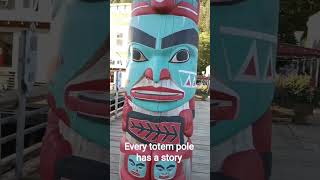Alaska cruise V37 – Every totem pole has a story. Read this pole's!
Alaska cruise V37 – Every totem pole has a story. Read this pole's!
 Totem poles are tall, carved poles traditionally created by Northwest Coast Indigenous peoples. They are not simply decorative, but rather represent a family’s or clan’s history, rights to territory, and lineage. These poles often feature symbolic carvings of animals, humans, or supernatural beings, each with specific meanings related to the family or clan.
Totem poles are tall, carved poles traditionally created by Northwest Coast Indigenous peoples. They are not simply decorative, but rather represent a family’s or clan’s history, rights to territory, and lineage. These poles often feature symbolic carvings of animals, humans, or supernatural beings, each with specific meanings related to the family or clan.
Key characteristics and functions of totem poles:
Carved from Red Cedar:
Totem poles are typically carved from red cedar, a wood prized for its durability and straight grain.
Symbolic Imagery:
The carvings on a totem pole represent a family’s or clan’s history, including their lineage, crests, stories, and spiritual beliefs.
Clan or Family Identity:
The pole acts as a visual representation of a specific clan or family’s identity, rights, and social standing.
Historical and Cultural Significance:
Totem poles are used to commemorate significant events, honor ancestors, and preserve cultural knowledge.
Memorials:
Totem poles can also serve as memorial poles, erected to honor the deceased.
Wealth and Status:
The creation of a totem pole was a significant undertaking, often indicating the wealth and status of the family commissioning it.
Variety of Poles:
There are different types of totem poles, including house frontal poles, house posts, mortuary poles, memorial poles, welcome poles, and shame/ridicule poles, each with its own specific purpose.
Ongoing Tradition:
The tradition of carving totem poles continues today, with contemporary artists preserving and adapting the art form.
